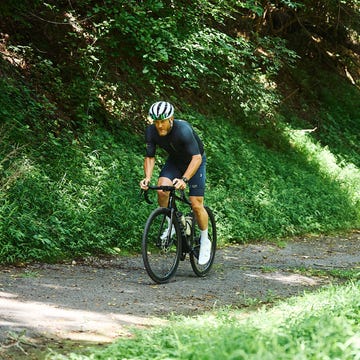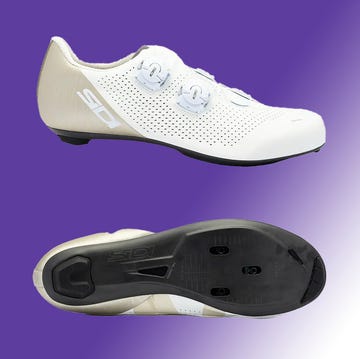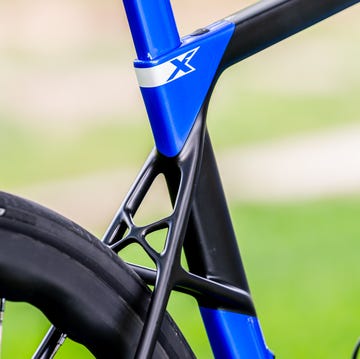Road is an expansive category covering everything from railtrail rides to racing, centuries to quick HIIT workouts, butter smooth tarmac to chip seal, and even some dirt road use. Road bikes can be featherweight, constructed with carbon fiber, and packed with electronic features, or they can be aluminum-framed and built for practicality with cable-actuated drivetrains and brakes.
Like the bicycles, no two road cyclists are identical or use their bikes in the same way. So, our editors test bikes in ways you ride them. We go to group rides and events, put them through their paces on fast lunch rides, grind out long miles on weekends, race them in criteriums, and ride them to the coffee shop. We dive into the minutia of each bike to give us insights into how each bike solves a rider’s problems and evaluate the bike based on overall value, ride quality, and how it stacks up against other bikes we rode.
Road bikes in 2025 are designed for riding with speed and comfort over long distances. The category’s trends are increased tire and rim widths, tubeless tire compatibility, and improved aerodynamics. Electronic drivetrains are found on most performance-oriented road bikes, and disc brakes are now universal across the category.
The test editors rode and evaluated hundreds of bicycles to establish the year’s Bike Award winners. We divided these Awards into four main categories: Road, Gravel, Mountain, and E-Bike. Below are our editors’ six Best Road Bikes and reviews for each 2025 Bike Award Winner. —Tara Seplavy, Deputy Editor
Trek Madone SL 5 GEN 8
BEST VALUE RACE
There is no point in dancing around it, Trek made a good bike with the latest version of the Madone. And that should come as no surprise for a platform eight generations (over twenty-one years) in the making. With all this expertise—and wider tires that make current road racing bikes ride more comfortably than bikes from only a few years prior—I expected the new Madone to impress. And it delivered.
When your aero bike is as light as your climbing bike, or your climbing bike is as aero as your aero bike, there doesn’t seem to be a point to having two bikes anymore. So, while fans of the Émonda might be sad to see it retired, the platform’s exit made way for the return of the Madone as the ultimate road racing bike in Trek’s lineup. This feels right, given the rich history of the Madone name.
I logged quite a few miles on the new Madone, and while I know that sensations are not statistics, the new Madone feels very fast. On a flat and fast weekly group ride I do, I found myself rolling off the front of the group when it was my turn to take a pull at the front. Despite the lack of deep aero tubes, the new Madone certainly has the sensation of speed that the best aero race bikes often possess. It’s best described as feeling like you’re riding with a permanent tailwind.
While some brands limit their top-end platforms to high-priced models and electronic groupsets, Trek delivers the Madone 8’s performance and premium feel for $3,499. Equipped with Shimano’s excellent 12-speed 105 mechanical shifting drivetrain, hydraulic disc brakes, and tubeless wheels, the Madone SL 5 provides much of the speed and aerodynamics of Madone SLR models costing upwards of three times its price. —Dan Chabanov
Canyon Aeroad
BEST AERO BIKE
The Aeroad is a fast bike. It looks fast and even makes the woosh-woosh sound of going fast. Everything about the Aeroad screams speed from the moment you push the pedals. It has the stiffness and crackling jump a top-end, high-performance race bike should have. And like you would expect from reportedly one of the most aerodynamic bikes in the WorldTour, once it gathers a bit of speed, it refuses to give it up.
The Aeroad is simply excellent for going fast on flat or rolling terrain. It offers the most benefit from its outstanding aerodynamics and power transfer when the topography or your legs allow as much speed as possible. On several local descents I know very well, I had to change my braking points to compensate for the few extra mph I was carrying on the Aeroad compared to my usual go-to bike (more of an all-rounder than a dedicated aero bike).
The new Aeroad frame looks very similar to the outgoing model, but Canyon made plenty of tweaks and updates throughout. According to Canyon, every tube was refined to improve aerodynamics and stiffness, decrease weight, and improve compliance. Additionally, many of the tubes were reinforced to make them more impact-resistant. For example, the new top tube is broader and features a reinforced layup. For riders, that means improved front-end stiffness and (hopefully) lowers the likelihood that a handlebar strike results in frame failure. A similar philosophy was applied to the seat tube and seat stays, which Canyon claims are slightly overbuilt for durability.
For riders who care about going fast, whether in a race situation or capturing a PR on a local Strava segment, the Aeroad is undoubtedly one of the most efficient tools. It’s also an excellent deal (relative to other big brands) if you’re looking at top and mid-tier builds. However, double-check the stock stem length for your size (and factor in the replacement cost if needed) before clicking the buy now button. —D.C.
Cervelo Caledonia 5
BEST FONDO BIKE
Cervélo bills the Caledona-5 as its bike for “Big, Stupid Rides”; long-distance and high-speed. However, it appeals to more riders than those only seeking to ride far or flat out. The Caledonia is a road bike for cyclists seeking the comfort, convenience, and handling of an endurance bike with the appearance and aero features of a modern road race bike.
From across the shop floor, the Caledonia-5 looks like a modern road race bike. It has a similar visual profile and integrated front end to Cervélo’s R5 stage race bike, combined with aerodynamic elements like dropped seatstays and a larger diameter downtube seen on the brand’s Aspero-5 gravel racing platform. However, the Caledonia does not have the radically aerodynamic features of Cervélo’s S5 aerobike. The Caledonia-5 is coated in a subdued, but classy, burgundy paint (Cervélo calls it Carmine; black is also available).
Upon closer inspection of the bike’s geometry chart, the nuances and differences between the Caledonia-5 and road race bikes become clearer. The Caledonia has a taller stack height, slacker head angle, and longer chainstays than most brands’ dedicated race models. Compared to the R5, the Caledonia has added bottom bracket drop (the BB‘s distance below the axle centerline) and fits slightly larger tires.
For the rider, these details translate to a slightly more upright seated position, added stability at speed, and a little more comfort than a race bike. On the road, the Caledonia feels akin to a race bike in its stiffness and ability to hold speed, but with added capability over broken pavement and loose surfaces.
My only quibbles with the Caledonia were the downtube storage and the tires. The integrated storage hides a tube, CO2, and a small multi-tool in the downtube (accessed via a hatch under the bottle cage). There isn’t much storage, and the hatch seems over-engineered (I found it faster and easier to use a seat bag). As for the tires, the stock Vittoria Corsa Nexts are not my favorites—they roll fast but are not as compliant or grippy as the Corsa Pro model—and I would prefer the added comfort and traction of 32s versus the stock 30mm width rubber.
Usually, I am not a big fan of endurance road bikes. Brands often tune them to feel somewhat dull and too upright. However, Cervélo strikes the right balance with the Caledonia-5; it feels lively like a race bike in acceleration and straight-line speed and is taller in the front end without being overly short in reach. This Cervélo ticks the right boxes for many road cyclists seeking a race bike look and feel without race bike geometry. —Tara Seplavy
Scott Addict RC Pro
BEST ROAD RACE
Even in the current era of aero-optimization, lightweight bikes possess a magical quality. Light bikes seem to dance up climbs with added grace, float like hummingbirds over smooth tarmac, and rapidly reply to inputs of power. Plus, a lightweight bike will impress even your most jaded cycling friends when they pick it up.
I am that jaded cycling friend, and the Scott Addict RC’s weight impressed me before I even rode the bike. When my test bike arrived, I initially wondered if Scott sent me only a frameset or shipped the wheels in a separate package because the box felt impossibly light.
The Scott Addict RC Pro tipped the scales at a scant 15.14 pounds…in an XL/58cm frame with Garmin Rally pedals, two cages, a computer mount, a hidden tool, and sealant in the tires.
To beat the UCI’s minimum weight requirement, riders often use boutique parts from small manufacturers, insanely light wheels, or even modified components to tease out every milligram. When brands construct impressively lightweight production bikes, they cut grams using special edition framesets with less paint or fancy carbon layups, carbon-spoked wheelsets, and compact gearing to avoid excess weight.
Scott does not employ any of these tactics on the Addict RC Pro. My 58cm bike comes pretty darned close to the 14.99 pound target with a standard frameset, full Shimano Dura-Ace Di2 drivetrain (using 52/36T chainrings and 11-34T cassette), tubeless carbon wheelset with DT Swiss 240 hubs and Aerolite stainless steel spokes, and 30mm wide Schwalbe Pro One tubeless tires. (In case you’re curious, Scott makes an Addict RC Ultimate model with a lighter weight frame and fork, one-piece carbon wheels, 29mm tube-type tires, and SRAM Red AXS with compact gearing. It weighs a claimed 13.01 pounds and costs $15,000.)
Scott’s weight-saving efforts would be for nought if the Addict RC rode like a dog. Luckily, the only dog it resembles is a greyhound. The RC Pro is a purebred road race bike; it is flat out fast in every situation I put it through. I am not a naturally gifted climber, but I eagerly reach for the Addict for rides with any notable elevation gain. The bike glides up double-digit gradients even with its non-compact gearing.
On rolling terrain, the Addict RC holds its own against aero-optimized bikes. While it does not have the hyper-speed rush of an all-in aerobike (like Scott’s Foil RC) on flat pavement, it also doesn’t feel like a sail in a crosswind or like you are bruising a kidney on washboard sections of road. The Addict is aero-enough for everyday rides, particularly for riders who regularly ride in the hills.
The Addict RC excels surprisingly well on descents—the bike rips. It elicited wide grins and silly giggles from me the first time I let off the brakes and pushed the Addict deep into a turn. Scott’s choice of grippy 30mm wide Schwalbe tires inspires confidence and adds control when the road tilts downwards, particularly when turns are involved.
Scott’s product team and engineers optimized the Addict RC’s handling around the 30mm width tires and 25mm ID rims. “Larger tires have the tendency to make the handling of a bike more lazy/sluggish as they increase the fork trail,” a Scott representative told me. He added, “We adapted head tube angles and fork trails and developed a specific stiffness layout (with a stiffer rear-triangle) to compensate for this effect and recover the agility and ‘snappy’ handling that we were used to from riding with narrower tires.”
However, the Addict’s longer reach meant I could not get my preferred fit with the stock cockpit. If you like long and low race bikes, you will get on well with the Addict RC. The sizing is slightly unconventional, and the long stem (120mm on the 58cm) and 15mm offset post stretched me out on the bike more than desired. I opted for a 5mm offset post since it was simpler than swapping the stem.
Due to a unique steerer tube size, you cannot use a traditional bar and stem on the Addict RC. The steerer tube is round but has a 27.2 mm diameter. Scott claims this new size was required “for a good stiffness-to-weight ratio” and to use its new fork manufacturing process. So, you’re locked into the brand’s Syncros cockpits.
Aside from the quirky steerer diameter, most parts on the Addict have performed exceptionally well. Problems are rare when a bike has a full Dura-Ace drivetrain and rolls on DT Swiss 240 hubs. One note: Scott does not equip the Addict RC Pro with a power meter, so budget some extra money if you need one.
Scott’s Addict RC should be on your short list if you seek a lightweight road or race bike this season. It rides like a race bike but with the geometry, tire clearance, and versatility many all-road bikes claim but rarely attain. If the RC Pro’s nearly $9,000 price tag is too steep for your budget, Scott offers Ultegra and 105 Di2-equipped Addict RC models using the same frame and fork starting at $4,999. —T.S.
Blackheart Road AL
BEST CRIT BIKE
Aluminum is an unfairly maligned road bike frame material. As it is relatively low-cost, lightweight, and easy to manufacture, it is ubiquitous on mass-produced, entry-level bikes. Thus, many cyclists mistakenly characterized aluminum as “cheap” or less worthy than materials like carbon fiber or titanium for constructing high-performance frames.
However, we’re big fans of aluminum bikes, due to excellent examples like BlackHeart’s Road AL. It’s a fast, edgy, and dynamic road bike that combines a classic aesthetic with modern standards and quick handling.
On pavement, the BlackHeart is sharp and stiff. It accelerates quickly and climbs better than its weight might suggest. This provides advantages on criterium circuits or rides with many corners and fast accelerations. The Road AL has predictable handling but also a bit of an edge and bite. It’s similar to Specialized’s Allez Sprint—you cannot be lazy with the Road AL in a corner.
The frameset uses mostly round 7005 aluminum tubes paired with an Enve Road fork; it doesn’t have radical aerodynamic shaping or use proprietary parts. Updates to the platform—a T47 bottom bracket, a Universal Derailleur Hanger (UDH), and clearance for up to 34mm (measured) width tires—help ensure easy service and forward compatibility with new parts. An example of the benefits of compatibility and common sizing: The Road AL ships with a 31.6mm diameter carbon post, which I swapped for a 27.2mm Zipp carbon post (and a shim) to add extra comfort on long rides. You can’t do that on a bike with a proprietary aero post!
With SRAM Force AXS, Zipp cockpit, Reserve 42|49 wheels, and 32mm Bontrager tires, my Road AL weighs 19.4 pounds with pedals and cages—not superlight but built with robust and dependable parts. BlackHeart offers complete builds with prices starting at $3,399 for SRAM Rival AXS with Hunt alloy wheels. The brand also has electronic shifting groups from SRAM, Shimano, and Campagnolo, along with many wheelsets, cockpit, and component detail options.
BlackHeart’s customization sets the Road AL apart from other aluminum road models. While you cannot change geometry (the brand offers eight frame sizes; 46cm to 62cm), custom Cerakote frame paint and logo colors (choose from 137 options) are included in the $1,699 frameset price (+$200 for custom fork color).
Matching a bike’s theme to a team kit is a touch usually reserved for Olympians or World Champions. While I am most certainly neither, BlackHeart finished this test bike in “Pink Sherbet” and “Blue Raspberry” Cerakote to match my KruisCX team skinsuits. This paint option makes the Road AL a compelling choice for privateer racers, small teams, or anyone who wants a personalized and unique look.
The BlackHeart Road AL has as much personality and flair as you desire. It’s a custom road bike for riders without the budget or patience for a frame with custom geometry. Plus, it rides as well (or better) than many bikes from far more recognizable and bigger brands. —T.S.
Parlee Ouray
BEST ALL ROAD
After many hours and miles riding the Parlee Ouray, it became clear that I must recommend this exceptional bike to most road riders. In fact, most cyclists would need to find compelling reasons NOT to ride an Ouray.
The Ouray is an easy bike to own and maintain. It's future-proofed with a UDH derailleur hanger, T47 threaded bottom bracket, round seat post, and external post clamp. While brake hose routing is internal, Parlee makes multiple transition adapters, allowing riders to choose their preferred cockpit (one-piece or two-piece) from several brands' offerings. This is a contemporary bike that even your mechanic will love (or at least not hate as vehemently).
The Ouray's buying process is another standout feature. Parlee offers twelve build kits (six SRAM and six Shimano) and no-extra-cost custom builds. Buyers can select their cockpit dimensions, crank length, and tire width at no additional charge. While this service should be standard with every high-end bike, it remains surprisingly rare.
The stock “waxed carbon” finish is subtly gorgeous and complements the Ouray's clean profile. The structural carbon isn't hidden beneath a cosmetic layer of carbon or paint; it showcases the craftsmanship of Parlee’s European manufacturing partner. Parlee offers nearly unlimited custom finish choices for those seeking more vibrant options.
Tire clearance is generous—officially up to 38mm, though 40mm will fit—and the bike features a taller front end, allowing more riders to achieve a comfortable position. And for the slam-your-stem crowd, note that the new thinking is "lower is slower," suggesting you might realize a more aerodynamically efficient position on a taller bike like the Ouray.
While substantial tire clearance and a tall head tube might suggest sluggish handling and reduced speeds, enlightenment will strike you like lightning with one ride on an Ouray. This is an unquestionably high-performance bike. It is lightweight, incorporates aerodynamic frame shaping for improved efficiency, and delivers a reactive and communicative ride without harshness.
The Ouray is snappy, fast, and fun—all while offering composed handling, accommodating large tires, and maintaining a reasonable riding position. This Parlee is as close to perfect as road bikes get in 2025. —Matt Phillips
As Deputy Editor, Tara Seplavy leads Bicycling’s product test team; after having previously led product development and sourcing for multiple bike brands, run World Championship winning mountain bike teams, wrenched at renowned bicycle shops in Brooklyn, raced everything from criteriums to downhill, and ridden bikes on six different continents (landing herself in hospital emergency rooms in four countries and counting). Based in Easton, Pennsylvania, Tara spends tons of time on the road and trail testing products. A familiar face at cyclocross races, crits, and bike parks in the Mid Atlantic and New England, on weekends she can often be found racing for the New York City-based CRCA/KruisCX team. When not riding a bike, or talking about them, Tara listens to a lot of ska, punk, and emo music, and consumes too much social media.

A gear editor for his entire career, Matt’s journey to becoming a leading cycling tech journalist started in 1995, and he’s been at it ever since; likely riding more cycling equipment than anyone on the planet along the way. Previous to his time with Bicycling, Matt worked in bike shops as a service manager, mechanic, and sales person. Based in Durango, Colorado, he enjoys riding and testing any and all kinds of bikes, so you’re just as likely to see him on a road bike dressed in Lycra at a Tuesday night worlds ride as you are to find him dressed in a full face helmet and pads riding a bike park on an enduro bike. He doesn’t race often, but he’s game for anything; having entered road races, criteriums, trials competitions, dual slalom, downhill races, enduros, stage races, short track, time trials, and gran fondos. Next up on his to-do list: a multi day bikepacking trip, and an e-bike race.
Test Editor Dan Chabanov got his start in cycling as a New York City bike messenger but quickly found his way into road and cyclocross racing, competing in professional cyclocross races from 2009 to 2019 and winning a Master’s National Championship title in 2018. Prior to joining Bicycling in 2021, Dan worked as part of the race organization for the Red Hook Crit, as a coach with EnduranceWERX, as well as a freelance writer and photographer.

























